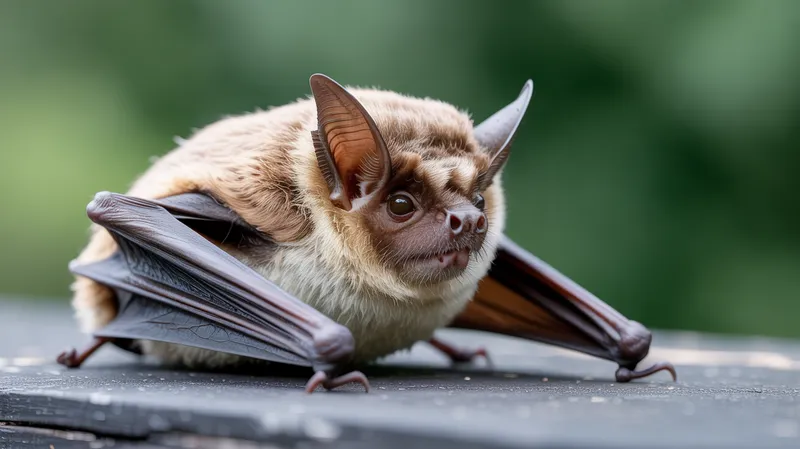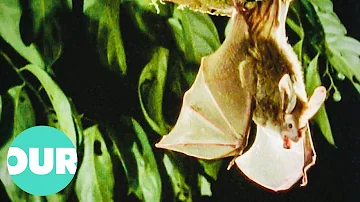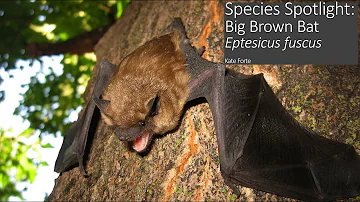
Big Brown Bat
Eptesicus fuscus

Meet the Big Brown Bat
The Big Brown Bat is a widespread and robust species of bat native to North America, easily recognized by its large size and glossy brown fur. Adaptable and resilient, it inhabits a wide range of environments, including forests, cities, and agricultural areas, often roosting in buildings, trees, and caves. This nocturnal mammal is an expert insectivore, relying on echolocation to hunt flying insects such as beetles and moths during the night. Big Brown Bats play a crucial ecological role by controlling pest populations, and they are one of the most common bats found in urban environments.
Classification
Mammal
Habitat
Forests, urban areas, and agricultural lands
Diet
Carnivore
Lifespan
6-20 years
Conservation
Least Concern
Weight
14–31 grams
📖Fascinating Facts
Echolocation Experts
Big Brown Bats use sophisticated echolocation calls to navigate in complete darkness and locate their insect prey with remarkable precision.
Urban Adaptation
This species readily adapts to human environments and is frequently found roosting in buildings, barns, and bridges.
Pest Controllers
A single Big Brown Bat can eat thousands of insects in one night, helping to naturally control agricultural pests.
📋Detailed Description
The Big Brown Bat (Eptesicus fuscus) is a medium-to-large vesper bat, notable for its robust build and glossy, chocolate-brown dorsal fur, with lighter, buff-colored underparts. Adults typically weigh between 15 and 26 grams and have a wingspan ranging from 32.5 to 35 centimeters. Their broad, rounded wings and relatively short, rounded ears distinguish them from other North American bats. The face is blunt with a pronounced muzzle, and the tail membrane (uropatagium) is relatively short. Big Brown Bats possess strong jaws and teeth, adapted for crushing hard-bodied insects. Their eyesight is moderate, but they rely primarily on sophisticated echolocation, emitting frequency-modulated calls for navigation and prey detection. These bats are highly adaptable, roosting in a variety of natural and artificial structures, including tree cavities, caves, attics, and bridges. They are nocturnal, emerging at dusk to forage, and can tolerate a wide range of climates, from temperate forests to urban environments. In colder regions, they enter hibernation during winter, often forming small hibernacula. Socially, they may form maternity colonies in spring and summer, while males are more solitary or form small bachelor groups.
💡 Did you know?
Big Brown Bats have been observed surviving subfreezing temperatures for months by lowering their metabolic rate during hibernation.
🔬Research & Sources
Wikipedia Summary
The big brown bat is a species of vesper bat distributed widely throughout North America, the Caribbean, and the northern portion of South America. It was first described as a species in 1796. Compared to other microbats, the big brown bat is relatively large, weighing 15–26 g (0.53–0.92 oz) and possessing a wingspan of 32.5–35 cm (12.8–13.8 in).
Last Modified: 5/23/2025
🎭Behavior & Social Structure
Big Brown Bats are crepuscular to nocturnal, typically emerging shortly after sunset to forage. Their flight is steady and direct, with moderate maneuverability, allowing them to efficiently patrol open spaces and forest edges. They are opportunistic insectivores, with a diet dominated by beetles (Coleoptera), but also including moths, wasps, true bugs, and other flying insects. Prey is detected and tracked using echolocation, with calls adapted to open or cluttered habitats. Foraging bouts last several hours, with individuals returning to roosts to digest and rest. Social interactions are most pronounced in maternity colonies, where females exhibit communal care and vocal communication. Males are generally solitary outside the breeding season. During the day, bats roost in dark, sheltered sites, often returning to the same location for extended periods. Grooming, vocalizations, and social behaviors such as allogrooming are observed within colonies.
👶Reproduction & Life Cycle
Mating in Eptesicus fuscus occurs in late summer to early autumn, often during swarming events near hibernation sites. Females store sperm over winter and fertilization takes place in spring after emergence from hibernation. Gestation lasts approximately 50 to 60 days, with young born between late May and early July, depending on latitude. Litter size is typically one or two pups. Newborns are altricial, blind, and hairless, weighing about 2 grams. Mothers nurse their young in maternity colonies, with pups clinging to the mother or roost substrate. Weaning occurs at 3 to 5 weeks, and juveniles begin to fly and forage independently soon after. Females reach sexual maturity in their first year, while males may mature slightly later. Parental care is provided solely by the mother.
🛡️Adaptations & Survival
Big Brown Bats exhibit several adaptations for survival in diverse environments. Their powerful jaws and robust teeth enable them to consume hard-shelled beetles, a dietary niche less exploited by other bats. Echolocation calls are adapted for both open and cluttered spaces, with frequency modulation allowing precise prey localization. They possess a high tolerance for urban environments, readily exploiting buildings for roosting and adapting to anthropogenic food sources. Physiologically, they can enter torpor or hibernation to survive cold winters, reducing metabolic rate and conserving energy. Their immune systems are relatively robust, contributing to their resilience against pathogens such as the fungus responsible for white-nose syndrome, compared to more susceptible bat species.
🎨Cultural Significance
Big Brown Bats are often encountered in urban settings, leading to both positive and negative perceptions. They are valued for their role in natural pest control, reducing populations of agricultural and nuisance insects. In some regions, they are featured in local folklore and are associated with good fortune or as symbols of rebirth and transition due to their nocturnal habits and seasonal hibernation. Occasionally, misconceptions about disease transmission (notably rabies) have led to unwarranted fear and persecution, though actual risk to humans is low with proper precautions.
🔬Recent Research & Discoveries
Recent research has focused on the Big Brown Bat's resistance to white-nose syndrome, revealing immune responses and behavioral adaptations that may inform conservation strategies for more vulnerable species. Studies on urban ecology have highlighted their ability to thrive in cities, utilizing artificial roosts and adapting foraging strategies to novel environments. Bioacoustic research has detailed the plasticity of their echolocation calls, showing how they adjust frequency and intensity in response to habitat structure and prey type. Genetic studies have explored population structure across their wide range, indicating high gene flow and adaptability. Ongoing work examines their role in ecosystem services, particularly in agricultural pest suppression.
🎥Wildlife Videos

The Rarely Seen Nightlife Of Bats & Why They Are Vital For The Earth | Our World
This film looks at why these creatures will play a vital role in mankind's future existence on Earth. This film was first broadcast: 05 ...
Our World

Species Spotlight: Big Brown Bat
In this video series, you will learn about various species that call Burlington County Parks home. Naturalist Kate will highlight a ...
Burlington County Parks

Big Brown Bat | CREATURE FEATURE #7
A hidden big brown bat (Eptesicus fuscus) is revealed with natural history notes and point-blank looks. YouTube Channel: ...
Marty Calabrese

BIG BROWN BAT - (2023) 😂
Welcome to our fascinating journey into the enigmatic realm of the Big Brown Bat! In this captivating exploration, we unveil the ...
ADVANCED WILDLIFE REMOVAL SERVICES IN NEW JERSEY..

Meet the Big Brown Bat!
Learn all about Rhode Island's most common bat species, the big brown bat! Music: bensound.com Rhody Critter Kit theme: M.
RI Department Of Environmental Management

Wild America | S4 E1 Beneficial Bats | Full Episode HD
Long the misunderstood subject of myth and legend, Bats are hardly a favorite form of wildlife. Yet they are among our most ...
Wild America Animal Channel
🌍Habitat Information
The Big Brown Bat typically inhabits Forests, urban areas, and agricultural lands environments. Big Brown Bats have adapted to their environments with specialized features and behaviors.
Primary Habitat:
Forests, urban areas, and agricultural lands
More detailed habitat information will be available soon.
🛡️Conservation Status
The Big Brown Bat is currently classified as Least Concern. Conservation efforts are crucial for preserving this species for future generations.
Common Threats:
- 🏠Habitat loss and fragmentation
- 🌡️Climate change impacts
- 🎯Hunting and poaching
- 🏭Human-wildlife conflict
⚠️Threats & Conservation Challenges
While currently listed as Least Concern, Big Brown Bats face several threats. Habitat loss due to urbanization and agricultural expansion can reduce available roosting and foraging sites. Pesticide use diminishes insect prey and can cause secondary poisoning. White-nose syndrome, a fungal disease devastating to many North American bats, affects E. fuscus but with lower mortality rates than in other species. Collisions with wind turbines and disturbance of hibernacula also pose risks. Despite these challenges, their adaptability and use of human structures have allowed populations to remain stable or even increase in some areas. Monitoring is ongoing to detect potential population declines.
🔬Scientific Classification
Scientific Name
Eptesicus fuscus
Classification Hierarchy
🔍 About Taxonomic Classification
Taxonomic classification is a hierarchical system used by scientists to classify and organize living organisms based on shared characteristics and evolutionary relationships.
The system moves from broad categories (Kingdom) to increasingly specific ones, with each animal's scientific name typically consisting of its Genus and species.
📝Community Notes
Share your observations and insights about the Big Brown Bat with our community of wildlife enthusiasts.
Join Our Community
Sign in to share your observations and connect with fellow wildlife enthusiasts.
Sign In to ContributeNo community notes yet
Be the first to share your observations about the Big Brown Bat!
Explore Big Brown Bat
Select a tab above to learn more about this amazing animal.
📸Photo Gallery
No photos available for this animal yet.
🌟Discover More Wildlife
Continue your journey of discovery with more fascinating animals from our database
